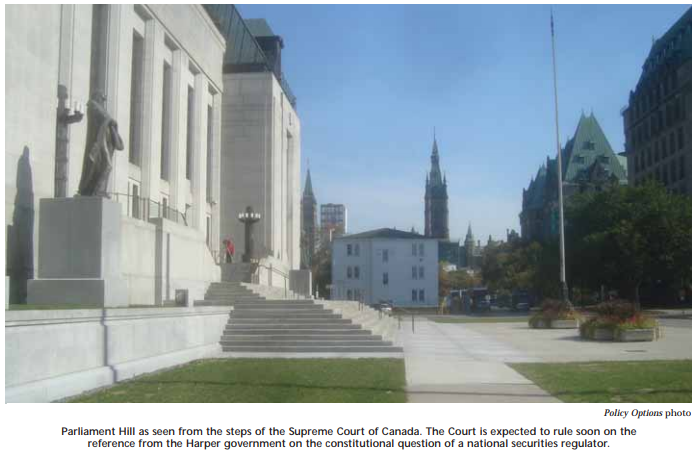
Unlike other industrialized countries, Canada does not have a national securities regulator. The local nature of Canadian capital markets has led the courts to repeatedly approve and recognize provincial jurisdiction over securities regulations under property and civil rights pursuant to s.92(13) of the Constitution Act, 1867. As a result, Canada has 13 sets of rules and regulations administered by 13 different provincial and territorial securities regulators. However, globalization and advances in technology have transformed the financial landscape. Most companies, regardless of their provincial origin, are now traded on the Toronto Stock Exchange (TSX) and seek to raise capital on a national, if not international, basis. Recent turbulence in capital markets has highlighted the inefficiency and fragmentation of the current passport system to address fraud and provide adequate investor protection. The Canadian securities mosaic is in desperate need of a reform.
In May of 2010, the federal government responded by releasing a proposed Canadian Securities Act. This federal scheme seeks to harmonize existing provincial securities legislation in the form of a single statute and create a single national securities regulator. It will also replicate and replace existing Criminal Code offences. The proposed Act operates on a voluntary basis, applicable only in those provinces that elect to be bound by the legislation.
Shortly after its release, and rather predictably, the proposed Act was met with opposition. Some provinces argue that the proposed Act infringes on provincial jurisdiction over securities regulation and consumer protection derived from s.92 (13), (15) and (16) of the Constitution Act, 1867. A constitutional reference was directed to the appellate courts of Quebec and Alberta by the respective provinces and also to the Supreme Court of Canada by the Government of Canada. The issue at stake is whether the general arm of the federal power to regulate trade and commerce could be invoked to validate the proposed Act and justify federal intrusion into provincial domain on the basis that securities regulations now serve an interprovincial and international capital market. While the decision of the Supreme Court is still pending as of this writing, the appellate courts reached a similar verdict: the Act is unconstitutional because it entered into a provincial area of regulation and it did not meet the traditional test for inclusion in the trade and commerce power. While compelling, these decisions are not binding on the Supreme Court. Extrapolating from leading decisions in General Motors of Canada Ltd. v. City National Leasing and Kirkbi AG v. Ritvik Holdings Inc., this paper proposes that the Supreme Court may still find in favour of the Government of Canada. What follows is a brief summary of the development of the general branch of the trade and commerce power leading up to the traditional test for inclusion outlined in General Motors. The constitutional validity of the Act will be assessed using this test. Subsequently, the narrative will shift to a discussion of the shortcomings of the appellate decision.
Most companies, regardless of their provincial origin, are now traded on the Toronto Stock Exchange (TSX) and seek to raise capital on a national, if not international, basis. Recent turbulence in capital markets has highlighted the inefficiency and fragmentation of the current passport system to address fraud and provide adequate investor protection. The Canadian securities mosaic is in desperate need of a reform.
Under s.91(2) of the Constitution Act, 1867, the federal government has the power to enact legislation to regulate trade and commerce. However, read literally, this clause would give the government unlimited authority to legislate over economic matters and completely divest the provinces of their power under s.92(13). This would not only go against the grain of the democratic principle and intention of the Constitution to create a federal country, but it would also upset the balance of provincial and federal power. The Privy Council in Citizens Insurance Company v. Parsons limited federal authority over trade and commerce to two situations: (1) the regulation of interprovincial or international trade; and (2) the general regulation of trade affecting the whole dominion. While possible criteria for inclusion under the general branch was first suggested in Vapor Canada Ltd v. McDonald and Attorney General of Canada v. Canadian National Transportation, the traditional test for inclusion was affirmed in General Motors. Here, Chief Justice Brian Dickson summarized the following five indicia of whether federal legislation is addressing a national economic concern and not a collection of local ones: (1) the presence of a “general regulatory scheme”; (2) the “oversight of a regulatory agency”; (3) concern “with trade as a whole rather than a particular industry”; (4) legislation of “a nature that the provinces jointly or severally would be constitutionally incapable of enacting”; and (5) “failure to include one or more provinces or localities in a legislative scheme would jeopardize the successful operation of the scheme in other parts of the country.” Use of such indicia serves to maintain the balance of federalism and prevent federal powers from encroaching onto provincial jurisdiction.
It should be noted that this list is neither exhaustive nor determinative and can be amended in the future. Failure to meet one criterion does not necessarily demonstrate the constitutional invalidity of legislation. Rather, the presence of all five factors simply means that there is a strong possibility that the federal legislation in question is constitutional under s.91(2) of the Constitution Act, 1867. Nevertheless, jurisprudential history suggests that a careful case-by-case analysis remains appropriate.
As affirmed by the appellate courts of Quebec and Alberta, the Act meets the first two indicia of valid use of the general branch of trade and commerce power set out above. However, from this point onwards, the direction of this paper and the lower courts’ decisions part ways.
The third indicia of valid use of the general branch of trade and commerce power is that the legislation is directed at regulating trade as a whole rather than a specific industry. The general regulation of trade as a whole necessarily overlaps with trade within the borders of each province. Thus to minimize encroachment into provincial jurisdiction, the purpose of this part of the test is to ensure that federal legislation regulates the economy as one national unit. Consequently, it is not enough that federal legislation be desirable or that it would impose uniform regulation across the nation. For if that were the case, division of power and federalism would bear little meaning. Legislation must apply to multiple industries in order to fulfill this criterion.
In General Motors, the Supreme Court concluded that the third factor was met because the regulation was “aimed at eliminating commercial practices which are contrary to healthy competition across the country, and not in a specific place, in a specific business or industry.” The Court thought that increased mobility of labour, capital, goods and technology across provincial boundaries required a national competition policy to promote and protect the national market and economy. Likewise, in Kirkbi, the Supreme Court unanimously upheld the federal Trade-Marks Act as valid legislation under the general branch of the trade and commerce power. Although concerned with trademarks, the Act satisfied the third criterion because businesses in all industries use trademarks. Thus, legislation regulating their use extends to the entire national economy. The same reasoning is applicable to securities regulations. The diversity of market participants involved in public issuance and trade of securities suggests that securities regulation is concerned with trade as a whole, rather than a particular industry. This approach is consistent with Justice Gérard La Forest’s comment in Black v. Law Society of Alberta. The dominant purpose of the Constitution Act, 1867 was not merely to establish national unity but also to create a national economy. Capital markets play an integral role in the infrastructure of the country: raising capital is foundational for all economic activity and is practised by companies in all sectors of the economy. Thus, the goals of securities regulation, namely transparency, investor protection and market efficiency, apply beyond the scope of market participants and serve the interests of the general public. Therefore, the proposed act is directed toward the regulation of trade in general and not a particular industry.
It is an indication of validity under s. 91(2) if the provinces jointly or severally are constitutionally incapable of enacting the federal scheme. One of the strongest arguments against the validity of the proposed act is that the provinces are capable of regulating securities on their own — and have done so for almost a century. However, the financial landscape has changed. Effective regulation requires control over both the interprovincial and intraprovincial trading of securities. Only Parliament can compel a uniform enforcement of its legislative scheme, since territorial boundaries and separate regulations preclude provinces from ensuring a nationwide regulatory uniformity. Past Supreme Court decisions upholding extraprovincial aspects of security regulation support this argument. In Unifund Assurance Co. v. Insurance Corp. of British Columbia, the Supreme Court upheld that a province may exercise its regulatory authority only over people, property and matters that are sufficiently connected to the province. What constitutes a sufficient connection depends on the relationship between a province and the subject matter. Likewise, in Global Securities Corp. v. British Columbia, the Court upheld a provincial securities legislation that allowed a provincial securities commission to require registered brokers to produce records for the purpose of assisting regulatory authority in another jurisdiction. These decisions suggest that regulation of interprovincial trade is required to effectively regulate intraprovincial trade. Therefore, the fourth factor is satisfied since provinces are incapable of jointly or severally enacting the type of legislation contemplated by a national regulatory regime.
The final factor identified by the Court in General Motors is that failure to include a province or localities in a legislative scheme would jeopardize the successful operation of the scheme in other parts of the country. Arguably, the optional nature of the Act makes the proposed federal scheme similar to and no more effective than the current provincially regulated passport system. Nevertheless, it is premature to conclude that the exclusion of any one province would not jeopardize the success of the act given that the federal scheme is designed to operate in such a fashion. The overall effectiveness of the Act in regulating securities would still be undermined by a regulatory failure in a nonparticipating province. In Multiple Access v. McCutcheon, the Supreme Court acknowledged the “interprovincial and indeed international character of the securities industry.” A regulatory failure in one province can adversely affect capital markets across the nation. This was exemplified in the 1997 Bre-X Minerals Ltd. scandal, where workers falsified core samples by salting them with gold dust. Despite being listed on the TSX, the scandal caused the Vancouver Stock Exchange (VSX) to experience a turnover slump. Market participants, including foreign investors, perceive Canada’s capital markets as one cohesive whole rather than a collection of regulatory bodies. Stock listing and place of incorporation do little to foster investor confidence in the integrity and fairness of regulated securities markets. Therefore, the final factor is satisfied because a regulatory failure in any one province would indeed jeopardise the successful operation of the Act in other parts of the country. Arguing to the contrary blatantly ignores, or at the very least, hastily discards, the government’s motive to allow for voluntary provincial participation in the first place. The Patriation Reference: Reference re a
Resolution to Amend the Constitution exemplifies provincial distaste for and opposition to federal attempts to impose a scheme without the consent of some or all of the provinces. The political strategy was likely adopted to avoid appearing as if to undercut provincial power in one fell swoop.
It is not the duty of the Court to question the wisdom of legislation, just its constitutionality. Rightly so, neither of the appellate Courts analyzed whether federal regulation would be more desirable. These are political, not legal, arguments.
It is not the duty of the Court to question the wisdom of legislation, just its constitutionality. Rightly so, neither of the appellate Courts analyzed whether federal regulation would be more desirable. These are political, not legal, arguments. Nevertheless, the unanimous decision of the Alberta Court of Appeal and the majority decision of the Quebec Court of Appeal adopted a narrow view of the nature of securities legislation and shirked from the real issue of the reference. The sales of securities to local investors made provincial regulation appropriate. However, the industry and the scope of regulation have grown substantially since the creation of the first provincial acts. Regulation now encompasses stock exchanges, foreign market participants and self-regulatory organizations — just to name a few. The scope of capital markets is now truly national and international in character and, quite fittingly, of federal concern. Summarizing the history of the trade and commerce power, Justice Dickson (as he then was) noted in Canadian National Transportation “that the limits of s.91(2) are not fixed, and that questions of constitutional balance play a crucial role in determining its extent in any given case at any given time.” Yet, instead of answering whether the federal government has the authority to enact the securities act, it seems that the appellate courts restricted their query to whether the historical treatment of securities can be disregarded in favour of allowing the federal government to take away the provincial right to regulate securities.
The decision of the appellate courts is hardly a forecast of what is to come. The Supreme Court has long recognized the interprovincial and international character of the securities industry. In Multiple and Global Securities Corp., the Supreme Court suggested that provincial authority over securities, as a matter of property and civil rights, does not, strictly speaking, deny the general branch of trade and commerce power as a basis for valid federal securities legislation. The Court’s willingness to consider this implies that the Court may likely conclude that regulation of securities is a valid use of Parliament’s ability to regulate trade affecting the whole dominion. In the event that the Supreme Court should find that the Act fails to satisfy any of the above indicia of the general branch of trade and commerce power, it does not necessarily follow that the Act will be deemed unconstitutional. The Supreme Court has emphasized that the presence of the five criteria is not necessarily determinative. Other factors can be added or amended by the Court to ensure an optimal balance between the division of power over the regulation of trade. The Act may not be perfect. Its voluntary nature invites critics to question its effectiveness when compared to the current provincially regulated passport system. Nevertheless, it represents the first step in the direction of regulating securities at the national level and strengthening Canada’s presence on the international arena.
This article is the runner-up in the second annual Policy Options Constitutional Affairs Competition, sponsored by Norton Rose OR LLP.
Photo: Shutterstock








